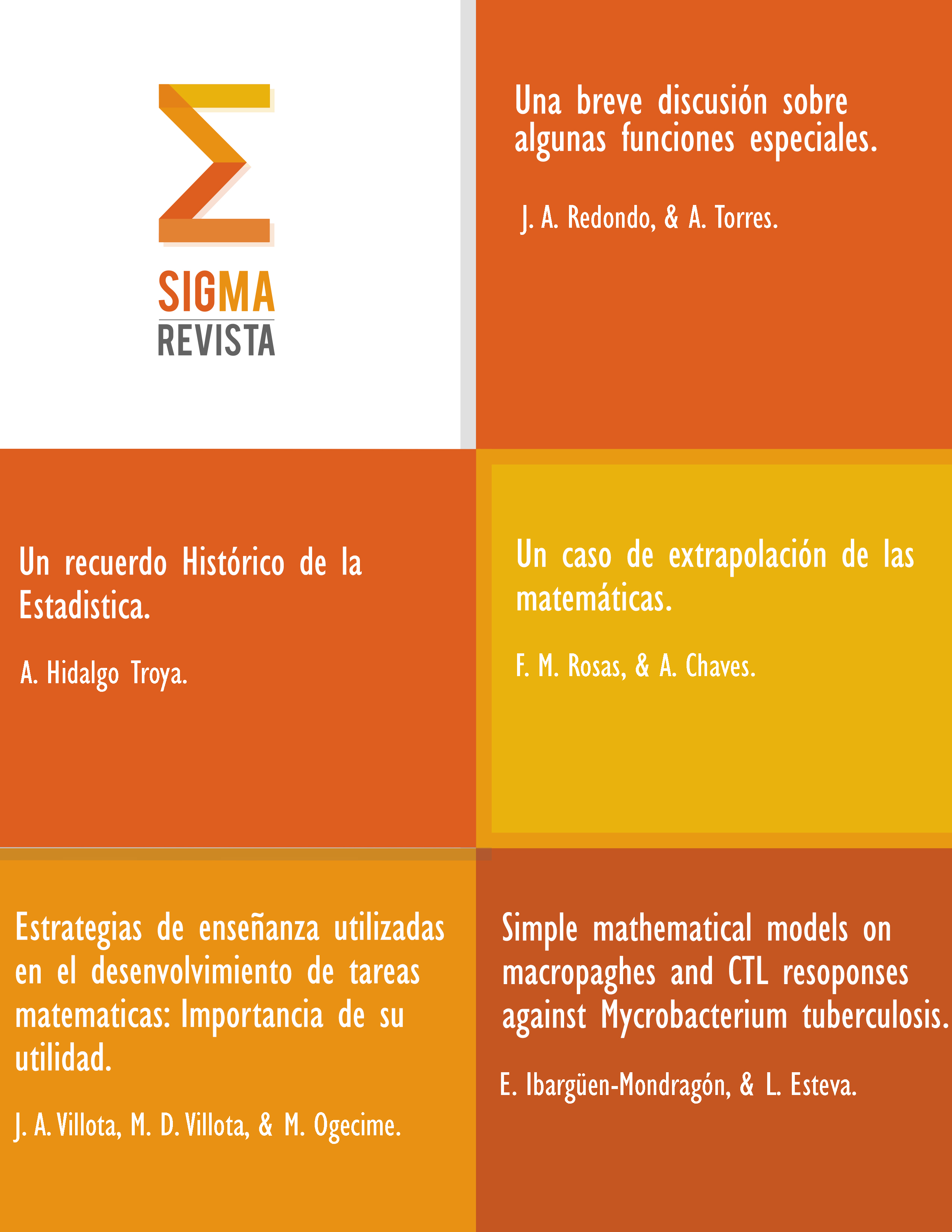Simple mathematical models on macrophages and CTL responses against Mycobacterium tuberculosis
Palabras clave:
Modelo matemático, Tuberculosis, Estabilidad, Inmunología, soluciones de equilibrio, Mathematical model, Stability, Immunology, Equilibrium solutions.Resumen
Resumen
En este trabajo se formulan cuatro modelos matemáticos que intentan describir aspectos básicos de la dinámica de la infección con el Micobacterium tuberculosis (Mtb) en diferentes etapas.
El propósito de este estudio es evaluar el impacto de la respuesta de las células T y los macrófagos en el control del Mtb.
Abstract
In this work we formulate fourth mathematical models trying to describe basic aspects
into the dynamics of theMycobacterium tuberculosis (Mtb) infection at different stages. The purpose
of this study is to evaluate the impact of the response of T cells and macrophages in the control of
Mtb.
Descargas
Citas
Global tuberculosis control: surveillance, planning, financing: WHO report 2008.
WHO/HTM/TB/2008.393. 31
Palomino-Leo-Ritacco, Tuberculosis 2007, From basic science to patient care. TuberculosisTextbook.
com, 2007, first edition. 31
J. Chan,J. Flynn, The immunological aspects of latency in tuberculosis, Clin. Immunol.
;110(1): 2-12. 31, 40
A. M. Gallegos, E. G. Pamer, M. S. Glickman, Delayed protection by ESAT-6-specific
effector CD4+ T cells after airborne M. tuberculosis infection. J. Exp. Med. 2008 Sep
;205(10):2359-68. 31, 40
M. Tsai, S. Chakravarty, G. Zhu, J. Xu, K. Tanaka, C. Koch, J. Tufariello, J. Flynn and
J. Chan, Characterization of the tuberculous granuloma in murine and human lungs:
cellular composition and relative tissue oxygen tension, Cell Microbiology, 8 (2006),
–232. 32
R. Antia, J. Koella, V. Perrot, Model of the Whitin-host dynamics of persistent mycobacterial
infections. Proc. R. Soc. Lond. B. 263(1996) 257-263. 32
D. Kirschner, Dynamics of Co-infection with M. tuberculosis and HIV-1. Theor Popul
Biol. 55(1999) 94-109. 32
DE. Kirschner, D. Sud, C. Bigbee, JL. Flynn, Contribution of CD8+T Cells to Control
of Mycobacterium tuberculosis Infection. The Journal of Immunology. 2006 April
;176(7)1: 4296-4314. 32
G. Magombedze, W. Garira, E. Mwenje, Modellingthe human immune response mechanisms
to mycobacteriumtuberculosis infection in the lungs, J.Mathematical Biosciences
and engineering, 2006, 3(3):661-682. 32
G. Magombedze, N. Mulder, Understanding TB latency using computational and dynamic
modelling procedures,Infection, Genetics and Evolution, 2013(13): 267283. 32
E. Ibargüen-Mondragón , L. Esteva, L. Chávez-Galán, A mathematical model for cellular
immunology of tuberculosis. J. Mathematical Eiosciences and Engineering, 2011
(4): 976-986. 32, 40
E. Ibargüen-Mondragón , L. Esteva, L., Un modelo matemático sobre la dinámica del
Mycobacterium tuberculosis en el granuloma. Revista Colombiana de Matemáticas, 2012
(1): 39-65. 32
E. Ibargüen-Mondragón and L. Esteva, L., On CTL Response against Mycobacterium
tuberculosis. Applied Mathematical Sciences, 2014 8(48):2383-2389. 32, 38, 39
J. Romero, E. Ibargüen-Mondragón, L. Esteva, Un modelo matemático sobre bacterias
sensibles y resistentes a antibióticos, Matemáticas: Enseñanza Universitaria, 2011
(1):5573. 32
E. Ibargüen-Mondragón, L. Esteva, On the interactions of sensitive and resistant Mycobacterium
tuberculosis to antibiotics, Math Biosci, 2013(246): 8493. 32
E. Ibargüen-Mondragón, S. Mosquera, M. Cerón, EM. Burbano-Rosero, SP. Hidalgo-
Bonilla, L. Esteva, JP. Romero-Leiton, Mathematical modeling on bacterial resistance
to multiple antibiotics caused by spontaneous mutations, BioSystems, 2014(117): 6067.
JP. Romero-Leiton and E. Ibargüen-Mondragón, Sobre la resistencia bacteriana hacia
antibióticos de acción bactericida y bacteriostática, Rev Integ., 2014(32): 101-116. 32
E. Ibargüen-Mondragón, EM. Burbano-Rosero, L. Esteva, JP. Romero-Leiton, Mathematical
modeling of bacterial resistance to antibiotics by mutations and plasmids,
Journal of Biological Systems, 2016 24(1): 1-18. 32
E. Ibargüen-Mondragón, L. Esteva, L. Chávez-Gálan, Estabilidad global para un modelo
matematico sobre la respuesta inmune innata de macrofagos contra elMicobacterium
tuberculosis, Revista Sigma, 2010 10(1): 1-17. 32
J. Alavez, J. Avendao, L. Esteva, J. Florez, J. Fuentes, G. García, G. Gómez, J. López,
Within-host population dynamics of antibiotic-resistant M. tuberculosis. Mathematical
Medicine and Biology. 2007 24(1):35-56. 32
P. Baloni, S. Ghosh, N. Chandra, Systems Approaches to Study Infectious Diseases,
Systems and Synthetic Biology, Springer, pp 151-172. 32
R. Shi, Y. Li and S. Tang, A mathematical model with optimal controls for cellular
immunology immunology of tuberculosis, Taiwanese Journal of mathematics, April 2014
(2):575-597. 32
A. Bru, P-J.Cardona, Mathematical Modeling of Tuberculosis Bacillary Counts and
Cellular Populations in the Organs of Infected Mice, PLoS ONE, 2014 5(9): e12985.
doi:10.1371/journal.pone.0012985. 32
H.M. Yang, Mathematical Modelling of the Interaction between Mycobacterium tuberculosis
Infection and Cellular Immune Response. In (Editor R. Mondaini): Proceedings
of BIOMAT 2011 (Santiago, Chile). World Scientific: Singapore: 309-330 (ISBN 13
-981-4343-42-8) 32
E. Guirado and LS. Schlesinger, Modeling the Mycobacterium tuberculosis granulomathe
critical battlefield in host immunity and disease, Frontier in immunology, 2013
(98): 1-7. 32
RV. Carvalho, J. Kleijn, AH. Meijer, and FJ. Verbeek, Modeling Innate Immune Response
to Early Mycobacterium Infection, Computational and Mathematical Methods
in Medicine, Volume 2012, 1-12. Article ID 790482. . 32
S. Goutelle, L. Bourguignon, RW. Jelliffe, J. E. Conte Jr., P. Maire, Mathematical
modeling of pulmonary tuberculosis therapy: Insights from a prototype model with
rifampin, Journal of Theoretical Biology, 2011(282): 8092. 32
E. Pienaar and M. Lerm, A mathematical model of the initial interaction between Mycobacterium
tuberculosis and macrophages, Journal of Theoretical Biology, 2014(342):
32
DG. Russell, Who puts the tubercle in tuberculosis?, Nat. Rev. Microbiol. 2007;5:39-47.
M. Nowak, R. May, Virus Dynamics, Oxford University Press, New York, 2000. 33
M. Y. Li and J. S. Muldowney, Global stability for the SEIR model in epidemiology.
Mathematical Biosciences. 1995 Febreary 125(2):155-164. 33
P. de Leenheer, HL. Smith. Virus Dynamics: a Global Analysis. SIAM J. Appl. Math.
(63):1313-1327. 33
A. Korobeinikov . Global Properties of Basic Virus Dynamics Models. Bull. Math. Biol.
a(66):879-883. 33
R. Van Crevel, T. Ottenhoff, J. Van der Meer. Innate Immunity to Mycobacterium
tuberculosis.American Society for Microbiology. 2002 15(2):294-309. 34, 40
J. Hale, Ordinary Differential Equations, Wiley, New York, 1969. 35


